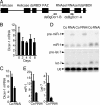MicroRNA-dependent metamorphosis in hemimetabolan insects
- PMID: 19966227
- PMCID: PMC2799836
- DOI: 10.1073/pnas.0907391106
MicroRNA-dependent metamorphosis in hemimetabolan insects
Abstract
How does a juvenile insect transform into an adult? This question, which sums up the wonder of insect metamorphosis, has fascinated mankind since ancient times. Modern physiology has established the endocrine basis regulating these transformations, which mainly depend on two hormone types: ecdysteroids, which promote molts, and juvenile hormones, which repress the transformation into the adult stage. The interplay of these two hormones regulates the genes involved in juvenile and adult programs and the shift from one to the other. microRNAs (miRNAs) are small noncoding RNAs, which participate in many biological processes, and we wondered whether they might be also involved in insect metamorphosis. In insects, Dicer-1 ribonuclease transforms miRNA precursors into mature miRNAs. Thus, using systemic RNA interference (RNAi) to silence the expression of Dicer-1 in the hemimetabolan insect Blattella germanica, we depleted miRNA contents in the last instar nymph. This practically inhibited metamorphosis after the next molt, as the resulting specimens showed nymphoid features and were able to molt again. The experiments show that miRNAs play a key role in hemimetabolan metamorphosis, perhaps regulating genes that are juvenile hormone targets.
Conflict of interest statement
The authors declare no conflict of interest.
Figures



References
-
- Nijhout HF. New Jersey: Princeton Univ Press Princeton; 1994. Insect hormones.
-
- Truman JW, Riddiford LM. Endocrine insights into the evolution of metamorphosis in insects. Annu Rev Entomol. 2002;47:467–500. - PubMed
-
- Rana TM. Illuminating the silence: Understanding the structure and function of small RNAs. Nat Rev Mol Cell Biol. 2007;8:23–36. - PubMed
Publication types
MeSH terms
Substances
Associated data
- Actions
LinkOut - more resources
Full Text Sources

